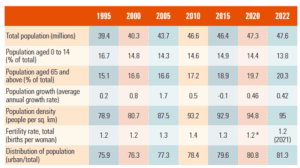US health spending growth decelerated in pandemic's second year – Healthcare Dive

Dive Brief:
National health spending grew an estimated 4.2% in 2021, reaching almost $4.3 trillion, according to annual spending projections released by the CMS. That’s a significant deceleration from the 9.7% growth rate seen in 2020, as the federal government ramped up spending to combat COVID-19, despite the increasing demand for patient care last year.
The CMS projects health spending will grow at an average rate of 4.9% between 2022 and 2024, and 5.3% between 2025 and 2030, to reach nearly $6.8 trillion by 2030.
Growth in the nation’s GDP is projected to be 5.1% annually over the same period, meaning healthcare spending will make up 19.6% of the GDP by 2030. That’s roughly the same as 2020’s share.
Dive Insight:
The first year of the pandemic in 2020 saw a mammoth increase in health spending, according to previous accounting.
That year, utilization dropped off drastically, but supplemental federal spending for the provider relief fund and other public health investments drove the U.S.’s health spending growth to 9.7% in 2020, a mammoth jump from the previous years’ rate of 4.3% — and the sharpest growth rate in more than a decade.
As a result of that increased health spending, along with a downturn in the overall economy, health spending as a percentage of the GDP rose from 17.6% in 2019 to nearly a fifth of the entire economy — 19.7% — in 2020.
Before the pandemic, the CMS predicted the U.S. wouldn’t reach this one-fifth benchmark until 2028.
It’s as of yet unclear whether the nation’s spending increase will continue based on 2020’s numbers, or whether the year was an outlier in terms of overall spending and growth rates.
Researchers including John Poisal, deputy director for National Health Statistics Group in the CMS, used the new projections, along with the CMS’ actuarial and econometric modeling methods, to try to look forward at health spending over the next decade in a new report published in Health Affairs on Monday.
Health spending growth is expected to slow to 4.2%, closer to pre-pandemic levels, in 2021, mostly due to a decline in federal supplemental funding.
That deceleration is expected to continue in 2022 to 2024, compared to 2020, as utilization returns to more normal levels, federal funding dries up and health insurance enrollments begin to return to pre-COVID-19 distributions.
By the end of 2024, the economy should begin to more fully recover from COVID-19. The resulting economic growth will outpace health spending growth, leading health spending growth as a percentage of the GDP to decline to just over 18% in this period — still exceeding the pre-pandemic level of 17.6%, researchers projected.
By 2030, the health spending share of GDP is projected to reach 19.6%, influenced more heavily once again by traditional economic, demographic and health-specific factors that drive changes in health spending and enrollment.
“While there is still considerable uncertainty around the COVID-19 pandemic, its related health and economic impacts are projected to lessen in the next few years,” Poisal said in a statement on the report. “From 2025 onward, we expect economic and demographic factors to reemerge as the most influential drivers of health sector spending trends.”
In 2021 specifically, the CMS found spending related to the pandemic fell sharply. Researchers estimated it dropped down to roughly $287 billion, versus $418 billion in 2020.
That’s also expected to have resulted in slower growth of spending on hospitals and physician and clinical services, though spending rates for both sectors are expected to accelerate in 2022 as demand for services rebounds.
Hospital spending is also projected to accelerate due to price growth, the CMS said.
Retail prescription drug spending accelerated in 2021 due to higher Medicaid drug spending as enrollment in the safety-net insurance hiked, but is forecast to slow in 2022.
Spending in Medicare and Medicaid is expected to have sharply accelerated in 2021, to 11.3% and 10.4% respectively as a result of faster projected growth in personal healthcare spending in Medicare, and faster enrollment growth in Medicaid.
Spending growth for both programs is expected to slow in 2022 and 2023 due to slowing service use and intensity of Medicare services, and as states are expected to resume eligibility checks for Medicaid, trimming rolls.
Private health insurance spending is estimated to have grown particularly rapidly after declining in 2020. That’s due to greater use of medical goods and services, and stabilization of economic and employment disturbances, the CMS said. However, researchers said growing demand is expected to accelerate private health insurance spending growth this year.
The CMS expects 91.1% of the population was covered by health insurance in 2022 and that percentage will remain stable in 2022, mostly due to the gains in Medicaid enrollment.
But those gains are largely tied to the public health emergency, which incentivized states to pause eligibility checks for Medicaid coverage. After the end of the emergency, enrollment is projected to begin returning to pre-pandemic distributions, which will cause the insured rate to lag to 89.8% by 2030, the CMS said.




